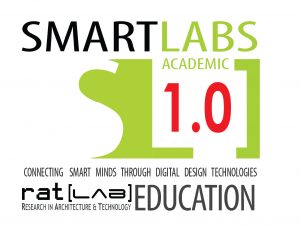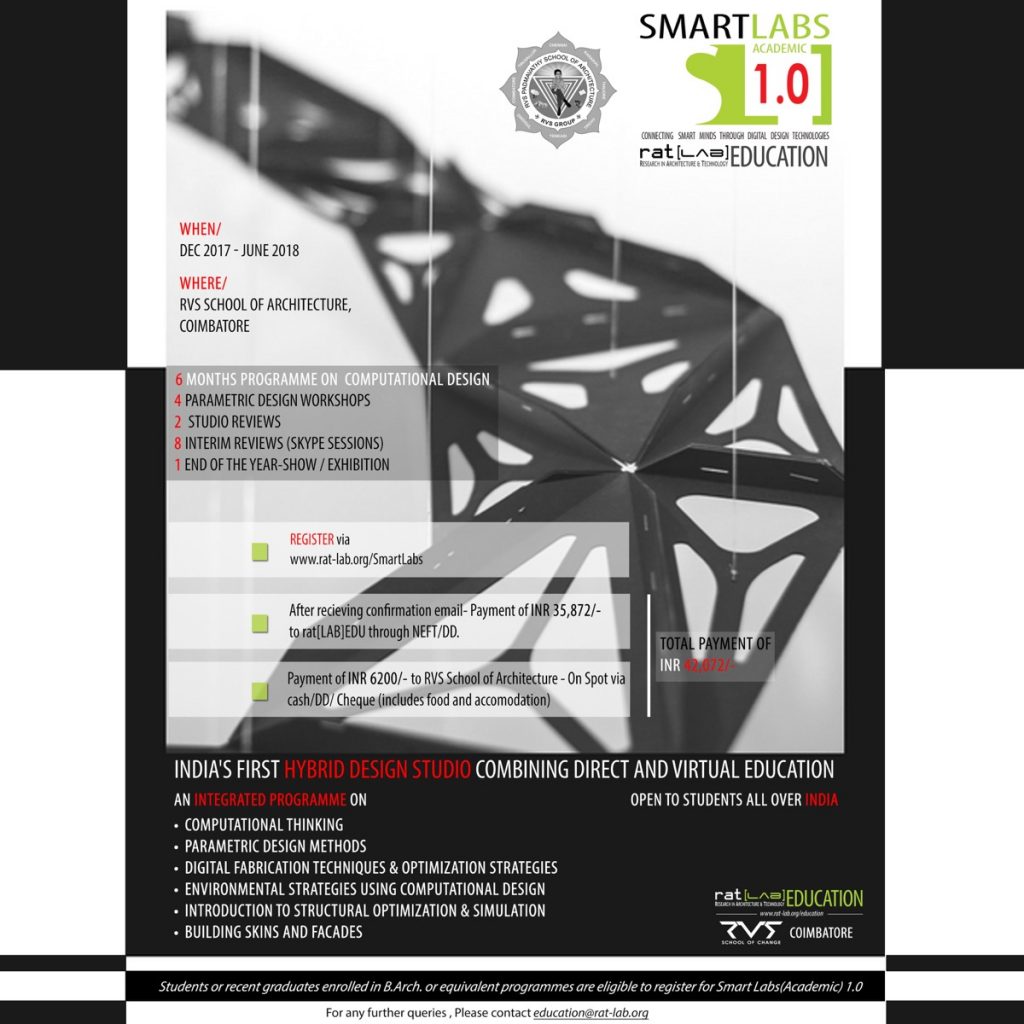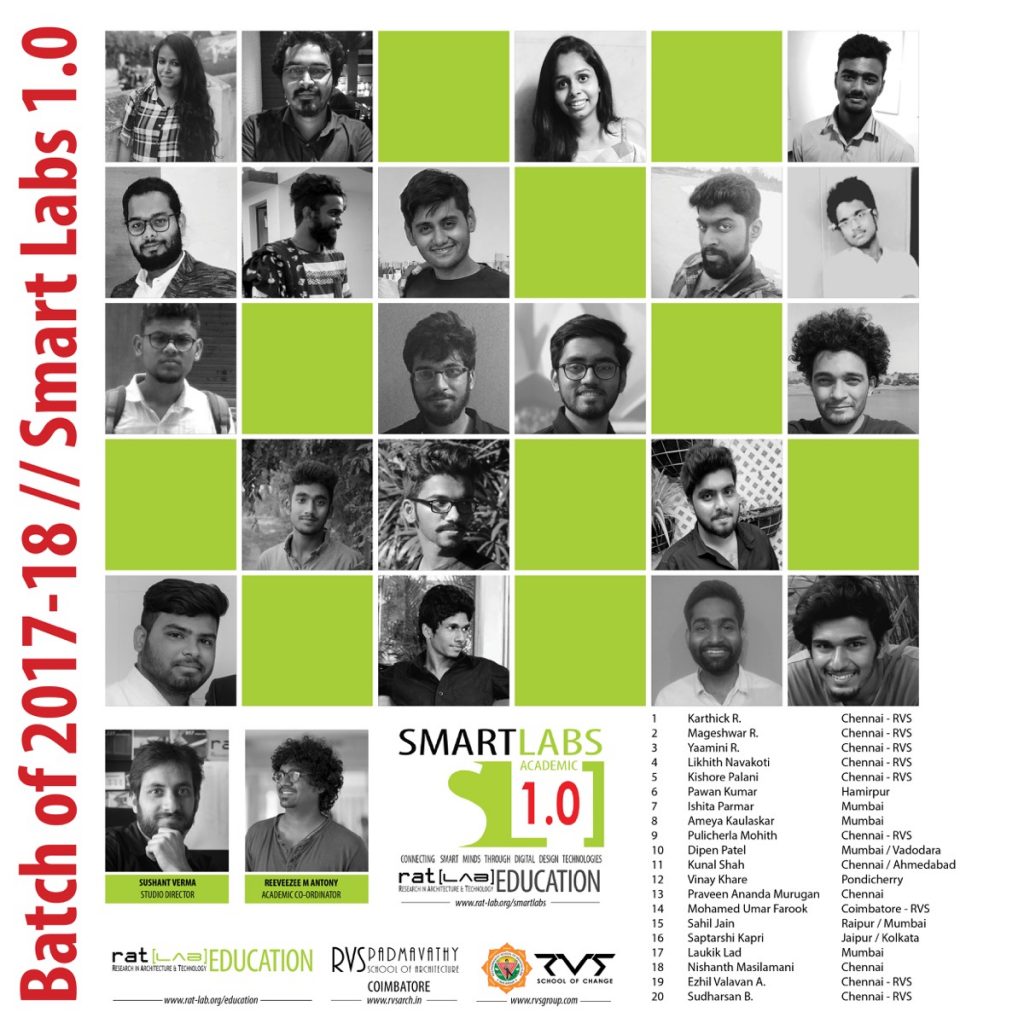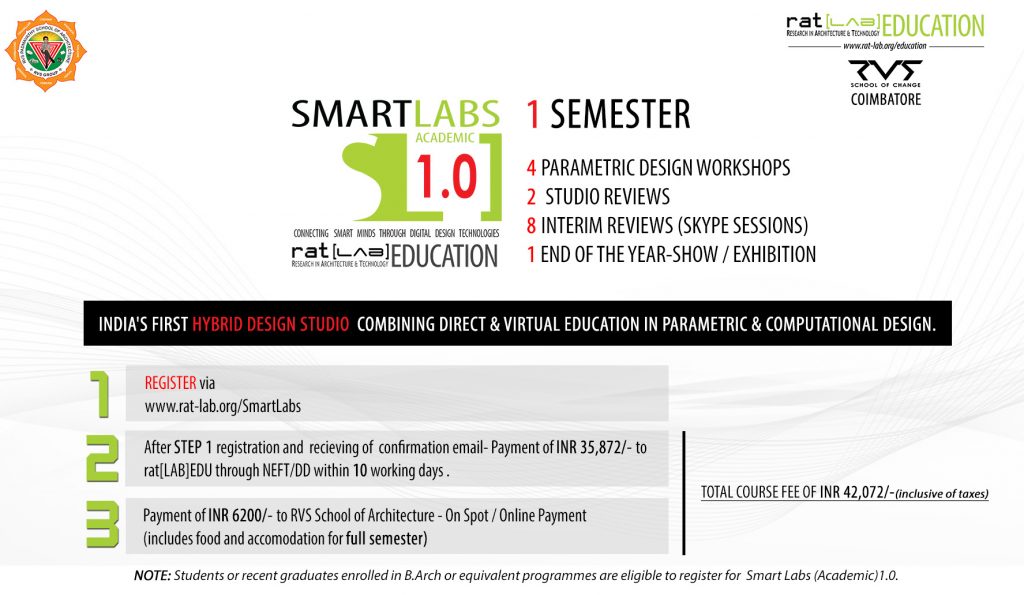 Architectural Education in India is about to experience a wave of change as rat[LAB]EDU launches India’s first 6 month (one semester) programme on Computational Design as a Hybrid Design studio, combining Studio and Online Classes on the eorate subject of Computational Design.
Architectural Education in India is about to experience a wave of change as rat[LAB]EDU launches India’s first 6 month (one semester) programme on Computational Design as a Hybrid Design studio, combining Studio and Online Classes on the eorate subject of Computational Design.
SMART LABS 1.0 by rat[LAB]EDU in collaboration with RVS School of Architecture, Coimbatore is INDIA’s FIRST HYBRID DESIGN STUDIO COMBINING DIRECT & VIRTUAL EDUCATION in Parametric & Computational Design. Smart Labs 1.0 is designed as a collaborative collective between rat[LAB]EDU & RVS School of Architecture, Coimbatore. It is an Integrated Programme to introduce basic, intermediate and advanced computational design techniques, methods, workflows on a 6 month basis. This programme is designed at par with any global school within the domain of computation and is envisioned to fill the missing gap in the educational curriculum by bridging academia & practice. Students will have an opportunity to work with the studio on live projects, thereby creating working opportunities and a real-time exposure to design practice, while developing their studio projects with a focus on Advanced Architectural Design and Computational Techniques. Digital Fabrication Techniques will be introduced to students through a hands-on experience as they get to develop prototypes of their projects for the Final Exhibition, that will be curated Offline & Online.
Smart LABS 1.0 comprises of 4 Parametric Design Workshops, 2 Studio Reviews, 8 Interim Reviews(Skype Sessions) and 1 End of the year- Show/ Exhibition.
This Integrated programme focusses on inculcating the following assets as a part of syllabus:
- Computational Thinking
- Parametric Design Methods
- Software (Rhino, Grasshopper, Maya), followed by Python Coding in subsequent years.
- Digital Fabrication Techniques and Optimization Strategies
- Environmental Strategies using Computational Design
- Introduction to Structural Optimization and Simulation
- Building Skins and Facades
The 6-month programme requires students to be present in Coimbatore Studio for 4 workshops and 2 reviews (in-person), while rest of the curriculum will be co-ordinated online. RVS School of Architecture will be providing food and accommodation to all non-resident students during these workshops and review sessions in Coimbatore.
Smart LABS in action:





![Smart Lab - rat[LAB]-Workshops17 Smart Lab - rat[LAB]-Workshops17](https://i0.wp.com/architecture.live/wp-content/uploads/2017/12/Smart-Lab-ratLAB-Workshops17.jpg?w=212&h=142&ssl=1)
![Smart Lab - rat[LAB]-Workshops14 Smart Lab - rat[LAB]-Workshops14](https://i0.wp.com/architecture.live/wp-content/uploads/2017/12/Smart-Lab-ratLAB-Workshops14.jpg?w=212&h=142&ssl=1)
![Smart Lab - rat[LAB]-Workshops19 Smart Lab - rat[LAB]-Workshops19](https://i0.wp.com/architecture.live/wp-content/uploads/2017/12/Smart-Lab-ratLAB-Workshops19.jpg?w=212&h=141&ssl=1)
![Smart Lab - rat[LAB]-Workshops4 Smart Lab - rat[LAB]-Workshops4](https://i0.wp.com/architecture.live/wp-content/uploads/2017/12/Smart-Lab-ratLAB-Workshops4.jpg?w=212&h=141&ssl=1)
![Smart Lab - rat[LAB]-Workshops5 Smart Lab - rat[LAB]-Workshops5](https://i0.wp.com/architecture.live/wp-content/uploads/2017/12/Smart-Lab-ratLAB-Workshops5.jpg?w=212&h=141&ssl=1)
![Smart Lab - rat[LAB]-Workshops6 Smart Lab - rat[LAB]-Workshops6](https://i0.wp.com/architecture.live/wp-content/uploads/2017/12/Smart-Lab-ratLAB-Workshops6.jpg?w=212&h=141&ssl=1)
![Smart Lab - rat[LAB]-Workshops8 Smart Lab - rat[LAB]-Workshops8](https://i0.wp.com/architecture.live/wp-content/uploads/2017/12/Smart-Lab-ratLAB-Workshops8.jpg?w=255&h=171&ssl=1)
![Smart Lab - rat[LAB]-Workshops18 Smart Lab - rat[LAB]-Workshops18](https://i0.wp.com/architecture.live/wp-content/uploads/2017/12/Smart-Lab-ratLAB-Workshops18.jpg?w=255&h=171&ssl=1)
![Smart Lab - rat[LAB]-Workshops3 Smart Lab - rat[LAB]-Workshops3](https://i0.wp.com/architecture.live/wp-content/uploads/2017/12/Smart-Lab-ratLAB-Workshops3.jpg?w=255&h=170&ssl=1)
![Smart Lab - rat[LAB]-Workshops25 Smart Lab - rat[LAB]-Workshops25](https://i0.wp.com/architecture.live/wp-content/uploads/2017/12/Smart-Lab-ratLAB-Workshops25.jpg?w=255&h=170&ssl=1)
![Smart Lab - rat[LAB]-Workshops24 Smart Lab - rat[LAB]-Workshops24](https://i0.wp.com/architecture.live/wp-content/uploads/2017/12/Smart-Lab-ratLAB-Workshops24.jpg?w=255&h=170&ssl=1)
![Smart Lab - rat[LAB]-Workshops20 Smart Lab - rat[LAB]-Workshops20](https://i0.wp.com/architecture.live/wp-content/uploads/2017/12/Smart-Lab-ratLAB-Workshops20.jpg?w=321&h=214&ssl=1)
![Smart Lab - rat[LAB]-Workshops10 Smart Lab - rat[LAB]-Workshops10](https://i0.wp.com/architecture.live/wp-content/uploads/2017/12/Smart-Lab-ratLAB-Workshops10.jpg?w=321&h=214&ssl=1)
![Smart Lab - rat[LAB]-Workshops9 Smart Lab - rat[LAB]-Workshops9](https://i0.wp.com/architecture.live/wp-content/uploads/2017/12/Smart-Lab-ratLAB-Workshops9.jpg?w=321&h=214&ssl=1)
![Smart Lab - rat[LAB]-Workshops1 Smart Lab - rat[LAB]-Workshops1](https://i0.wp.com/architecture.live/wp-content/uploads/2017/12/Smart-Lab-ratLAB-Workshops1.jpg?w=321&h=214&ssl=1)






